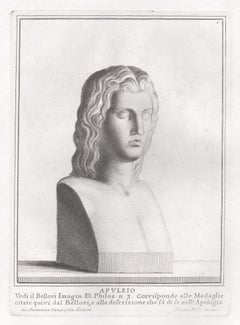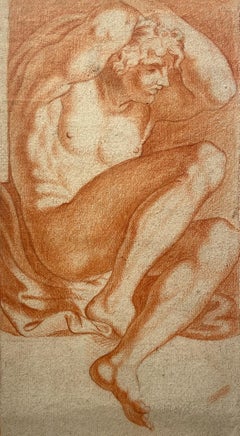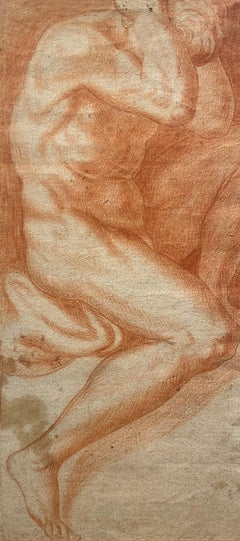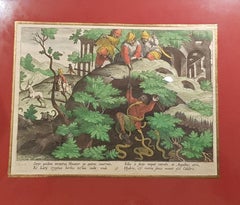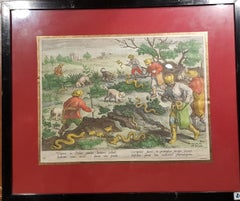Renaissance Art
to
1
11
2
2
2
39
6
40
2
2
2
Overall Height
to
Overall Width
to
2,225
1,094
40
19
9
3
41
26
26
17
15
11
5
4
4
3
3
2
1
1
1
1
1
1
1
1
115
48
106
50
1
2
1
1
78
2
4
46
1
38
4
3
2
2
Style: Renaissance
Period: 18th Century
Apuleius, Ancient Roman, C18th Grand Tour Classical antique engraving print
Located in Melbourne, Victoria
'Apuleio' (Apuleius)
Copper-line engraving by N Billy after Giovanni Domenico Campiglia. Plate number top right corner of image.
Giovanni...
Category
Mid-18th Century Renaissance Art
Materials
Engraving
The Captive, Study of a Naked Youth, Red Chalk Study, Carracci Gallery
By Annibale Carracci
Located in London, GB
Red chalk on paper
Image size: 5 x 8 1/2 inches (12.75 x 21.5 cm)
Mounted
This 18th century drawing is after the work of the 16th Century Italian artist Annibale Carraci. This figure, along with many more, were painted by Carraci in the Palazzo Farnese in a space now known as the Carracci gallery. The Carracci gallery is considered as one of the most important Renaissance commissions in Rome. This figure, along with five other companions, were known as 'The Captives'. They were designed by the artist to appear trapped in the architectural spaces in the walls and sat around the fresco that featured Perseus and Andromeda.
Similarly to the original drawings, this artist has taken considerable care to sculpt his form with light and shadow, gently blending strokes on the smooth-skinned cheek and distinctly denoting the direction of hair strands.
Annibale Carracci
Annibale Carracci (1560–1609) was the most admired painter of his time and the vital force in the creation of Baroque style. Together with his cousin Ludovico (1555–1619) and his older brother Agostino (1557–1602)—each an outstanding artist—Annibale set out to transform Italian painting. The Carracci rejected the artificiality of Mannerist painting, championing a return to nature coupled with the study of the great northern Italian painters of the Renaissance, especially Correggio, Titian, and Veronese.
During the 1580s, the Carracci were painting the most radical and innovative pictures in Europe. Annibale not only drew from nature, he created a new, broken brushwork to capture movement and the effects of light on form. His Two Children Teasing a Cat marks a new chapter in the history of genre painting. The revolutionary potential of this new kind of painting would be taken up over a decade later by Caravaggio, who must have seen the Carraccis’ work while traveling from Milan to Rome in 1592.
The Carracci saw themselves as heir to a great artistic tradition, and they consciously situated themselves within the history of northern Italian painting. Annibale and Agostino visited Parma and Venice to study the work of Correggio, Titian, Tintoretto, and Veronese. Their altarpieces and secular fresco cycles in Bologna reasserted a northern Italian emphasis on color, light, and the study of nature, but with a new focus on emotive communication. Their success led to Annibale being invited to Rome to work for the powerful Farnese family (1595). Ludovico remained in Bologna to direct the academy they founded. Through the next generation of painters—Francesco Albani, Domenichino, Guido Reni, Giovanni Lanfranco, and Guercino—Bolognese painting became the dominant force in seventeenth-century art.
In Rome, Annibale’s painting was transformed through his first-hand encounter with classical antiquity and the art of Michelangelo and Raphael. Individual scenes of ancient mythology are surrounded by an elaborate illusionistic framework with feigned statues, in front of which sit muscular nude figures seemingly lit from the actual windows (Galleria Farnese ceiling). The corners are opened to painted views of the sky. When unveiled in 1600, the ceiling was instantly acclaimed as the equal of any work in the past. In combining northern Italian naturalism with the idealism of Roman painting, Annibale created the basis of Baroque art. His only challenger in Rome was Caravaggio, whose relation with the past was combative rather than assimilative. Moreover, Caravaggio’s art...
Category
18th Century Renaissance Art
Materials
Chalk, Paper
The Captive, Study of a Naked Man, Red Chalk Study, Carracci Gallery
By Annibale Carracci
Located in London, GB
Red chalk on paper
Image size: 11 x 5 1/2 inches (28 x 14 cm)
Mounted
This 18th century drawing is after the work of the 16th Century Italian artist Annibale Carraci. This figure, along with many more, were painted by Carraci in the Palazzo Farnese in a space now known as the Carracci gallery. The Carracci gallery is considered as one of the most important Renaissance commissions in Rome. This figure, along with five other companions, were known as 'The Captives'. They were designed by the artist to appear trapped in the architectural spaces in the walls and sat around the fresco that featured Perseus and Andromeda.
Annibale Carracci
Annibale Carracci (1560–1609) was the most admired painter of his time and the vital force in the creation of Baroque style. Together with his cousin Ludovico (1555–1619) and his older brother Agostino (1557–1602)—each an outstanding artist—Annibale set out to transform Italian painting. The Carracci rejected the artificiality of Mannerist painting, championing a return to nature coupled with the study of the great northern Italian painters of the Renaissance, especially Correggio, Titian, and Veronese.During the 1580s, the Carracci were painting the most radical and innovative pictures in Europe. Annibale not only drew from nature, he created a new, broken brushwork to capture movement and the effects of light on form. His Two Children Teasing a Cat marks a new chapter in the history of genre painting.
The revolutionary potential of this new kind of painting would be taken up over a decade later by Caravaggio, who must have seen the Carraccis’ work while traveling from Milan to Rome in 1592.The Carracci saw themselves as heir to a great artistic tradition, and they consciously situated themselves within the history of northern Italian painting. Annibale and Agostino visited Parma and Venice to study the work of Correggio, Titian, Tintoretto, and Veronese. Their altarpieces and secular fresco cycles in Bologna reasserted a northern Italian emphasis on color, light, and the study of nature, but with a new focus on emotive communication. Their success led to Annibale being invited to Rome to work for the powerful Farnese family (1595). Ludovico remained in Bologna to direct the academy they founded. Through the next generation of painters—Francesco Albani, Domenichino, Guido Reni, Giovanni Lanfranco, and Guercino—Bolognese painting became the dominant force in seventeenth-century art.
In Rome, Annibale’s painting was transformed through his first-hand encounter with classical antiquity and the art of Michelangelo and Raphael. Individual scenes of ancient mythology are surrounded by an elaborate illusionistic framework with feigned statues, in front of which sit muscular nude figures seemingly lit from the actual windows (Galleria Farnese ceiling). The corners are opened to painted views of the sky. When unveiled in 1600, the ceiling was instantly acclaimed as the equal of any work in the past. In combining northern Italian naturalism with the idealism of Roman painting, Annibale created the basis of Baroque art. His only challenger in Rome was Caravaggio, whose relation with the past was combative rather than assimilative. Moreover, Caravaggio’s art...
Category
18th Century Renaissance Art
Materials
Chalk, Paper
Laocoön and his Sons, an exceptional bronze sculpture by Giacomo Zoffoli
Located in PARIS, FR
This exceptional bronze group (unpublished), executed in Rome in the second half of the 18th century, bears witness to the fascination with the Laocoön since its discovery on January...
Category
1770s Renaissance Art
Materials
Bronze
Hunting Engraving: Hunting Ibex With Snakes
Located in Paris, FR
Engraving: The Ibex hunting with snakes
Historical , mythological, religious, allegorical subjects, genre scenes, landscape painter.
Mannerist. He settled in Antwerp, Venice, Flore...
Category
18th Century Renaissance Art
Materials
Engraving
Engraving Hunting: The Hunt For The Vipers
Located in Paris, FR
Engraving, "the hunt for vipers" xylographs (wood and copper engravings), after Jan Van der Straeten, dit Stradanus (Bruges 1523-Florence 1605). Painter of history, mythological, rel...
Category
18th Century Renaissance Art
Materials
Engraving
Engraving Hunting: Deer Hunting With Lasso
Located in Paris, FR
Engraving: The Deer hunting
Woodcuts and copper engraving, after Jan Van der Straeten so called Stradanus (Bruges 1523-Florence 1605).
A historical, mythological, religious, allegorical, genre scenes, landscape and mural compositions painter.
He lived in Antwerp, Venice, Florence, where he worked for the Medici
He then met Vasari and worked with him at the the Vatican, the Palazzo Vechio ....
Out of a set of 5 prints:
- The Duck Hunting
- The ibex hunting with dogs...
Category
18th Century Renaissance Art
Materials
Engraving
Engraving Hunting: Hares Hunting With Cheetah
Located in Paris, FR
Engraving, "The hare hunt with Cheetah" xylographs (woodcuts and copper engravings), after Jan Van der Straeten, dit Stradanus (Bruges 1523-Florence 1605). Painter of history, mythol...
Category
18th Century Renaissance Art
Materials
Engraving
Virgil, Ancient Roman, C18th Grand Tour Classical antique engraving print
Located in Melbourne, Victoria
'Virgilio' (Virgil)
Copper-line engraving by Silvestro Pomared after Giovanni Domenico Campiglia. Plate number top right corner of image.
Giovanni Domenico Campiglia (1692–1768) wa...
Category
Mid-18th Century Renaissance Art
Materials
Engraving
Euripides, Ancient Greek, C18th Grand Tour Classical antique engraving print
Located in Melbourne, Victoria
'Euripide Poeta Tragico' (Euripides, Tragic Poet)
Copper-line engraving by Nicola Billy after Giovanni Domenico Campiglia. Plate number top right corner of image.
Giovanni Domenico...
Category
Mid-18th Century Renaissance Art
Materials
Engraving
Masinissa, King of Nubia, C18th Grand Tour Classical antique engraving print
Located in Melbourne, Victoria
'Massinissa re de' Numidi'
Copper-line engraving by Guttierez after Giovanni Domenico Campiglia. Plate number top right corner of image.
Giovanni Domenico Campiglia (1692–1768) was...
Category
Mid-18th Century Renaissance Art
Materials
Engraving
Terence, Ancient Roman, C18th Grand Tour Classical antique engraving print
Located in Melbourne, Victoria
'Terenzio' (Terence)
Copper-line engraving by Silvestro Pomared after Giovanni Domenico Campiglia. Plate number top right corner of image.
Giovanni Domenico Campiglia (1692–1768) w...
Category
Mid-18th Century Renaissance Art
Materials
Engraving
Mago of Carthage, Roman bust, C18th Grand Tour Classical antique engraving print
Located in Melbourne, Victoria
'Magone Cartaginese' (Magone of Carthage)
Copper-line engraving by Pazzi after Giovanni Domenico Campiglia. Plate number top right corner of image.
Giovanni Domenico Campiglia (1692–1768) was an Italian painter and engraver from Florence, active under the patronage of the House of Medici.
Illustration of an Ancient Roman marble bust from 'Musei Capitolini', a series of engravings showing the sculpture of the Capitoline Museum in Rome.
Mago I, also known as Magon, was the king of the Ancient Carthage...
Category
Mid-18th Century Renaissance Art
Materials
Engraving
Terence, Ancient Roman, C18th Grand Tour Classical antique engraving print
Located in Melbourne, Victoria
'Terenzio' (Terence)
Copper-line engraving by Silvestro Pomared after Giovanni Domenico Campiglia. Plate number top right corner of image.
Giovanni Domenico Campiglia (1692–1768) w...
Category
Mid-18th Century Renaissance Art
Materials
Engraving
Masinissa, King of Nubia, C18th Grand Tour Classical antique engraving print
Located in Melbourne, Victoria
'Massinissa re de' Numidi'
Copper-line engraving by Carlo Gregori after Giovanni Domenico Campiglia. Plate number top right corner of image.
Giovanni Domenico Campiglia (1692–1768)...
Category
Mid-18th Century Renaissance Art
Materials
Engraving
Cicero, Ancient Roman, C18th Grand Tour Classical antique engraving print
Located in Melbourne, Victoria
'Cicerone' (Cicero)
Copper-line engraving by C Gregory after Giovanni Domenico Campiglia. Plate number top right corner of image.
Giovanni Domenico Campiglia (1692–1768) was an Ita...
Category
Mid-18th Century Renaissance Art
Materials
Engraving
Homer, Ancient Greek, C18th Grand Tour Classical antique engraving print
Located in Melbourne, Victoria
'Omero' (Homer)
Copper-line engraving by Carlo Gregori after Giovanni Domenico Campiglia. Plate number top right corner of image.
Giovanni Domenico Campiglia (1692–1768) was an Italian painter and engraver from Florence, active under the patronage of the House of Medici.
Illustration of an Ancient Greek marble...
Category
Mid-18th Century Renaissance Art
Materials
Engraving
Bacchus, Ancient Roman bust, C18th Grand Tour Classical antique engraving print
Located in Melbourne, Victoria
"Bacco' (Bacchus)
Copper-line engraving by Silvestro Pomared after Giovanni Domenico Campiglia. Plate number top right corner of image.
Giovanni Domenico Campiglia (1692–1768) was an Italian painter and engraver from Florence, active under the patronage of the House of Medici.
Illustration of an Ancient Greek marble...
Category
Mid-18th Century Renaissance Art
Materials
Engraving
Copy of "Portrait of Beatrice dʼEste" by Leonardo da Vinci created 15th Century
Located in New York, NY
A masterful copy by an unknown artist, after the portrait of "Beatrice d'Este" by Leonardo Da Vinci also known as ‘Portrait of a Lady’ or ‘La Dama con la reticella di perle (The Lady With a Pearl Hairnet)’. The original work originally created in the 15th Century is currently on display in the Pinacoteca Ambrosiana Museum of Milan. Beatrice d'Este was the Duchess of Bari/Milan and was believed to be one of the most attractive princesses of the Renaissance. Her impeccable style won her many admirers throughout Italy and France, and she became a trendsetter of the highest order. This copy of the original painting, is an oil on canvas done in the 18th Century, and in this exquisite portrait, the artist has masterfully depicted the fine details with draped hair, pearls, royal dress, ornate headgear and sumptuous jewelry in front of a dark background. Once again, capturing the imagination with another enigmatic smile. It comes housed in an elegant period giltwood frame with ebonized trims and ready to be displayed with hanging wire on verso.
Art measures 28 x 18 inches
Frame measures 34.5 x 24.5 inches
There is much debate and controversy over who actually painted the "Beatrice d'Este" was it Leonardo da Vinci (1452–1519), or Giovanni Ambrogio de Predis (1455–1508). So we may never know who executed the original portrait which hangs in the museum, but that need not deter from an appreciation of its singularity. Following the portraiture convention established by painters of the Quattrocentro, the artist has chosen to portray his sitter in profile. In doing so, he magnificently captures the essence of his sitter, a girl on the threshold of womanhood. Bedecked in the adornments—silk, velvet, pearls and embroidery (brocade) crafted of spun gold threads—afforded her by birthright and marriage, Beatrice looks forward in noble serenity. And at the same time her profile with its upturned nose and slight smile betrays an innocence that must have been the basis of the oft-repeated epithet: la più zentil donna in Italia” (“the sweetest lady in Italy”).
It is believed the lady is Beatrice d'Este (1475-1497), duchess of Bari and later of Milan, the wife of Ludovico Sforza (known as "il Moro"). One of the most beautiful princesses of the Italian Renaissance, she was known for her good taste in fashion. Beatrice was a member of the Este-Sforza family, which joined by marriage two of the oldest reigning and already powerful houses in Italy. The house of Este, which held court in Ferrara, traced its lineage to the 11th century Dukes of Saxony and Bavaria. Beatriceʼs father, Ercole I ruled the Ferrara commune for 34 years, catapulting the city-state (and the Estes with it) to an unmatched level of economic prosperity and cultural prominence. The family was renowned for its love of letters and patronage of the arts.
The first time Leonardo da Vinci’s name resounded in the Ambrosiana, it was through the pen of its founder, Cardinal Federico Borromeo, who attributed this little panel to the great Master, describing it as “A portrait of a Duchess of Milan, by the hand of Leonardo”. Following the Cardinal’s statement, the portrait was for long assumed to depict Beatrice d’Este, the wife of Ludovico il Moro. However, scholars have recently been more cautious and vague in their statements, with regard to both the artist (anonymous Lombard or Emilian...
Category
18th Century Renaissance Art
Materials
Oil, Canvas
Hippocrates, Ancient Greek, C18th Grand Tour Classical antique engraving print
Located in Melbourne, Victoria
'Ippocrate' (Hippocratus)
Copper-line engraving by Pazzi after Giovanni Domenico Campiglia. Plate number top right corner of image.
Giova...
Category
Mid-18th Century Renaissance Art
Materials
Engraving
Heraclitus, Ancient Greek, C18th Grand Tour Classical antique engraving print
Located in Melbourne, Victoria
'Eraclito' (Heraclitus)
Copper-line engraving by Silvestro Pomarede after Giovanni Domenico Campiglia. Plate number top right corner of image.
Giovanni Domenico Campiglia (1692–176...
Category
Mid-18th Century Renaissance Art
Materials
Engraving
Apollonius of Tyana, Ancient Greek, C18th Classical antique engraving print
Located in Melbourne, Victoria
'Apollonio Tianeo' (Apollonius of Tyana)
Copper-line engraving by Carlo Gregori after Giovanni Domenico Campiglia. Plate number top right corner of image.
Giovanni Domenico Campigl...
Category
Mid-18th Century Renaissance Art
Materials
Engraving
Sappho, poet, Ancient Greek, C18th Grand Tour Classical antique engraving print
Located in Melbourne, Victoria
'Saffo' (Sappho)
Copper-line engraving by Carlo Gregori after Giovanni Domenico Campiglia. Plate number top right corner of image.
Giovanni Domenico Campiglia (1692–1768) was an Italian painter and engraver from Florence, active under the patronage of the House of Medici.
Illustration of an Ancient Greek marble bust from 'Musei Capitolini', a series of engravings showing the sculpture of the Capitoline Museum in Rome.
Sappho was an Archaic Greek...
Category
Mid-18th Century Renaissance Art
Materials
Engraving
Homer, Ancient Greek, C18th Grand Tour Classical antique engraving print
Located in Melbourne, Victoria
'Omero' (Homer)
Copper-line engraving by Carlo Gregori after Giovanni Domenico Campiglia. Plate number top right corner of image.
Giovanni Domenico Campiglia (1692–1768) was an Italian painter and engraver from Florence, active under the patronage of the House of Medici.
Illustration of an Ancient Greek marble...
Category
Mid-18th Century Renaissance Art
Materials
Engraving
Herodotus, Ancient Greek, C18th Grand Tour Classical antique engraving print
Located in Melbourne, Victoria
'Erodoto' (Herodotus)
Copper-line engraving by Carlo Gregori after Giovanni Domenico Campiglia. Plate number top right corner of image.
Giovanni Domenico Campiglia (1692–1768) was an Italian painter and engraver from Florence, active under the patronage of the House of Medici.
Illustration of an Ancient Greek marble bust from 'Musei Capitolini', a series of engravings showing the sculpture of the Capitoline Museum in Rome.
Herodotus was an ancient Greek historian and geographer from the Greek city of Halicarnassus, part of the Persian Empire. He is known for having written the Histories – a detailed account of the Greco-Persian Wars...
Category
Mid-18th Century Renaissance Art
Materials
Engraving
Hiero, Roman bust, C18th Grand Tour Classical antique engraving print
Located in Melbourne, Victoria
'Ierone Re di Sicilia' (Hiero, King of Sicily)
Copper-line engraving by Gregori after Giovanni Domenico Campiglia. Plate number top right corner of image.
Giovanni Domenico Campigl...
Category
Mid-18th Century Renaissance Art
Materials
Engraving
Pindar, Ancient Greek, C18th Grand Tour Classical antique engraving print
Located in Melbourne, Victoria
'Pindaro' (Pindar)
Copper-line engraving by Silvestro Pomared after Giovanni Domenico Campiglia. Plate number top right corner of image.
...
Category
Mid-18th Century Renaissance Art
Materials
Engraving
Hesiod, Ancient Greek, C18th Grand Tour Classical antique engraving print
Located in Melbourne, Victoria
'Esiodo' (Hesiod)
Copper-line engraving by Francesco Mazzoni after Giovanni Domenico Campiglia. Plate number top right corner of image.
Giovanni Domenico Campiglia (1692–1768) was an Italian painter and engraver from Florence, active under the patronage of the House of Medici.
Illustration of an Ancient Greek marble...
Category
Mid-18th Century Renaissance Art
Materials
Engraving
Pithodoris, Roman bust, C18th Grand Tour Classical antique engraving print
Located in Melbourne, Victoria
'Pitodoride'
Copper-line engraving by Carlo Gregori after Giovanni Domenico Campiglia. Plate number top right corner of image.
Giovanni Domenico Campiglia (1692–1768) was an Italia...
Category
Mid-18th Century Renaissance Art
Materials
Engraving
Aristophanes, Ancient Greek, C18th Grand Tour Classical antique engraving print
Located in Melbourne, Victoria
'Aristofane' (Aristophanes)
Copper-line engraving by Carlo Gregori after Giovanni Domenico Campiglia. Plate number top right corner of image.
Giovanni Domenico Campiglia (1692–1768) was an Italian painter and engraver from Florence, active under the patronage of the House of Medici.
Illustration of an Ancient Greek marble bust from 'Musei Capitolini', a series of engravings showing the sculpture of the Capitoline Museum in Rome.
Aristophanes, son of Philippus, of the deme Kydathenaion, was a comic playwright or comedy-writer of ancient Athens...
Category
Mid-18th Century Renaissance Art
Materials
Engraving
Theophrastus, Ancient Greek, C18th Grand Tour Classical antique engraving print
Located in Melbourne, Victoria
''Teofrasto' (Theophrastus)
Copper-line engraving by Silvestro Pomarede after Giovanni Domenico Campiglia. Plate number top right corner of image.
Giovanni Domenico Campiglia (1692–1768) was an Italian painter and engraver from Florence, active under the patronage of the House of Medici.
Illustration of an Ancient Greek marble...
Category
Mid-18th Century Renaissance Art
Materials
Engraving
Theon, Ancient Greek philosopher, C18th Classical antique engraving print
Located in Melbourne, Victoria
'Teone Platonico'
Copper-line engraving by Carlo Gregori after Giovanni Domenico Campiglia. Plate number top right corner of image.
Giova...
Category
Mid-18th Century Renaissance Art
Materials
Engraving
Giove Ammone, Ancient Greek, C18th Grand Tour Classical antique engraving print
Located in Melbourne, Victoria
'Giove Ammone' (Jupiter Ammon)
Copper-line engraving by Pazzi after Giovanni Domenico Campiglia. Plate number top right corner of image.
Giovanni Domenico Campiglia (1692–1768) was...
Category
Mid-18th Century Renaissance Art
Materials
Engraving
Metrodorus, Ancient Greek philosopher, C18th Classical antique engraving print
Located in Melbourne, Victoria
'Metrodoro' (Metrodorus)
Copper-line engraving by Carlo Gregori after Giovanni Domenico Campiglia. Plate number top right corner of image....
Category
Mid-18th Century Renaissance Art
Materials
Engraving
Lysias, Ancient Greek, C18th Grand Tour Classical antique engraving print
Located in Melbourne, Victoria
'Lisia' (Lysias)
Copper-line engraving by Pietro Parrocol after Giovanni Domenico Campiglia. Plate number top right corner of image.
Giovanni Domenico Campiglia (1692–1768) was an Italian painter and engraver from Florence, active under the patronage of the House of Medici.
Illustration of an Ancient Greek marble...
Category
Mid-18th Century Renaissance Art
Materials
Engraving
Asclepiades, Ancient Greek, C18th Grand Tour Classical antique engraving print
Located in Melbourne, Victoria
'Asclepiade' (Asclepiades)
Copper-line engraving by Silvestro Pomarede after Giovanni Domenico Campiglia. Plate number top right corner of image.
Giovanni Domenico Campiglia (1692–...
Category
Mid-18th Century Renaissance Art
Materials
Engraving
Queen Mary, Queen of England, royalty portrait engraving, circa 1780
Located in Melbourne, Victoria
'Marie'
Copper-line engraving by Pierre Francois Basan (1723-1797) after Van der vaart.
Mary II (1662-1694) reigned as Queen of England, Scotland, a...
Category
Late 18th Century Renaissance Art
Materials
Engraving
The Lamentation Of The Death Of Christ, 17th Century
Located in Blackwater, GB
The Lamentation Of The Death Of Christ, 17th Century
after Pier Francesco Mazzucchelli (1573-1626)
Fine huge 17th Century Italian Old Master depiction of the Lamentation at the Dea...
Category
18th Century Renaissance Art
Materials
Tempera, Panel
Aristomachus, Ancient Greek, C18th Grand Tour Roman bust engraving, 1741
By Carlo Gregori
Located in Melbourne, Victoria
'Aristomaco'
Copper-line engraving by Carlo Gregori after P Pazzi.
Illustration of a Roman bust of Cleopatra from 'Musei Capitolini' a series of engrav...
Category
Mid-18th Century Renaissance Art
Materials
Engraving
Diogenes the Cynic, Greek philosopher. C18th Grand Tour Roman bust engraving
Located in Melbourne, Victoria
'Diogene Cinico'
Copper-line engraving by Pazzi after Giovanni Domenico Campiglia (1692-1768).
From 'Musei Capitolini' a series of engravings showing the sculpture of the Capitoline Museum in Rome.
240mm by 170mm (platemark)
420mm by 270mm (sheet)
Diogenes, also known as Diogenes the Cynic, was a Greek philosopher...
Category
Mid-18th Century Renaissance Art
Materials
Engraving
Logge di Rafaele nel Vaticano (Raphael's Loggia in the Vatican) Plate X Pilaster
Located in San Francisco, CA
Artists: Raffaello Sanzio d’Urbino.(1483 – 1520)
Gateano Savorelli, artist. (unk.- 1791)
Ludovico Teseo, draughtsman. (1731-1782)
Pietro Camporesi, architect (1726 - 1781)
Giovanni Ottoviani (1735-1808) & Giovanni Volpato (1735 – 1803), engravers
Title: Delle Logge di Rafaele nel Vaticano, Plate X (10)
Year: 1772-1777
Medium: Hand-colored copperplate engraving
Sight size: 42 x 16 inches.
Framed size: 55.5 x 28.5 inches
Condition: Very good
Frame: Frame in very good condition
A tall and incredibly detailed printed panel, “Delle Logge di Rafaele nel Vaticano” (“Raphael Loggia...
Category
1770s Renaissance Art
Materials
Engraving
Pair of antique reverse glass paintings
Located in London, GB
Pair of antique reverse glass paintings
Continental, 18th Century
Frame: Height 46cm, width 40cm, depth 3.5cm
Glass: Height 38cm, width 32cm
T...
Category
18th Century Renaissance Art
Materials
Glass
George II, King of England, royalty portrait engraving, circa 1780
Located in Melbourne, Victoria
'George II'
Copper-line engraving by Pierre Francois Basan (1723-1797) after Founan.
Basan (1723-1797) was a French engraver and publisher.
George II (1683-1760) was King of Great Britain and Ireland, Duke of Brunswick-Leneburg (Hanover) and Archtreasurer and Prince-Elector of the Holy Roman Empire from 11 June 1727 until his death. He was the last British monarch to have been born outside Great Britain, and was famous for his numerous conflicts with his father and, subsequently, with his son. As king, he exercised little control over policy in his early reign, the government instead being controlled by Great Britain's de facto first Prime Minister, Sir Robert Walpole...
Category
Late 18th Century Renaissance Art
Materials
Engraving
George I, King of England, royalty portrait engraving, circa 1780
Located in Melbourne, Victoria
'George I'
Copper-line engraving by Pierre Francois Basan (1723-1797) after Founan.
Basan (1723-1797) was a French engraver and publisher.
George I (1660-1727) was King of Great Britain and Ireland from 1 August 1714 until his death, and ruler of Hanover in the Holy Roman Empire...
Category
Late 18th Century Renaissance Art
Materials
Engraving
Two oil on panel Old Master landscape paintings by Johannes Jakob Hartmann
Located in London, GB
Two oil on panel Old Master landscape paintings by Johannes Jakob Hartmann (Bohemian, 1680-1730)
Bohemia, early 18th Century
Panel: Height 73cm, width 93cm
Frame: Height 90cm, width...
Category
Early 18th Century Renaissance Art
Materials
Oil, Wood Panel
The Dead Bird, Large Oil Painting on Canvas by Louvre Copyist
Located in Cirencester, Gloucestershire
"The Dead Bird"
After Jean-Baptiste Greuze (1725-1805)
oil painting on canvas, late 20th century
from the studio of Dagher, Paris (read notes below), stampe...
Category
18th Century Renaissance Art
Materials
Canvas, Oil
Renaissance art for sale on 1stDibs.
Find a wide variety of authentic Renaissance art available for sale on 1stDibs. Works in this style were very popular during the 21st Century and Contemporary, but contemporary artists have continued to produce works inspired by this movement. Many Pop art paintings were created by popular artists on 1stDibs, including Ian Hornak, Jesus Nodarse, Roni Taharlev, and Theo Toy. Frequently made by artists working with Paper, and Paint and other materials, all of these pieces for sale are unique and have attracted attention over the years. Not every interior allows for large Renaissance art, so small editions measuring 2 inches across are also available. Prices for art made by famous or emerging artists can differ depending on medium, time period and other attributes. On 1stDibs, the price for these items starts at $100 and tops out at $675,000, while the average work sells for $1,450.
Recently Viewed
View AllMore Ways To Browse
Neon Yellow
French Painted Poster
Oil Painting 19th Century Man
Oil Painting Man 19th Century
Old Man Figure
Flower Hat
The Big Five
Distressed Paper
Antique Oil On Canvas In Gilt Frame
Wood Female Figure
Porter Vintage
Drew Gold
Vintage Air Force
Italian Late 19th Century Oil
Twenty Seven
Large 1906
Vintage Mid Century Oil On Canvas Painting
Stone Horse
